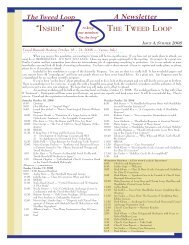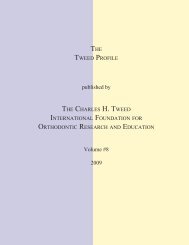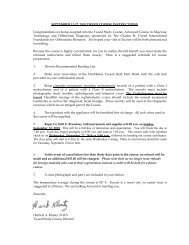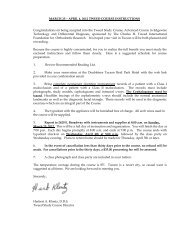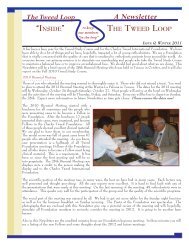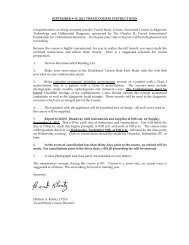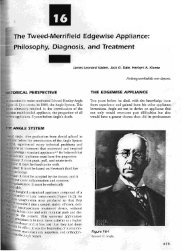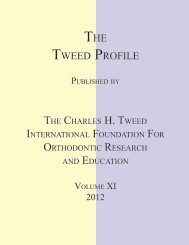the tweed profile - The Charles H. Tweed International Foundation
the tweed profile - The Charles H. Tweed International Foundation
the tweed profile - The Charles H. Tweed International Foundation
You also want an ePaper? Increase the reach of your titles
YUMPU automatically turns print PDFs into web optimized ePapers that Google loves.
RESULTS<br />
<strong>The</strong> average pretreatment values of <strong>the</strong> 92 malocclusions,<br />
both Class I and II were: FMIA 50.41º, FMA<br />
33.73º, IMPA 95.61º. Following <strong>Tweed</strong> Merrifield<br />
treatment, <strong>the</strong> average values had improved to <strong>the</strong><br />
following measurements: FMIA 58.36, FMA 33.99,<br />
IMPA 87.71. Table 1<br />
Before treatment, <strong>the</strong> average value of <strong>the</strong> lower lip<br />
to E-line was 5.2mm (SD 2.8mm). Following treatment,<br />
<strong>the</strong> average value had decreased to -0.1mm (SD<br />
1.5mm). Three months after debonding, <strong>the</strong> value had<br />
dropped even more to - 1.6mm (SD 0.7mm).<br />
Table 1<br />
<strong>The</strong> superimposed images of <strong>the</strong> before & after cephalometric<br />
images were shown to patients as is described<br />
by Fig 2 and also in <strong>the</strong> video movie.<br />
<strong>The</strong> average change to <strong>the</strong> position of <strong>the</strong> tip of <strong>the</strong><br />
chin was 4.7mm (SD 3.2mm). <strong>The</strong> changes to <strong>the</strong> lip<br />
positions were: -2.3mm (SD 2.6mm) for <strong>the</strong> upper lip<br />
and -2.3mm (SD 3.1mm) for <strong>the</strong> lower lip.<br />
<strong>The</strong> <strong>Tweed</strong> Merrifield orthodontic movie has been<br />
uploaded to a YouTube website.<br />
DISCUSSION<br />
<strong>The</strong> average values of <strong>the</strong> <strong>Tweed</strong> triangle for <strong>Tweed</strong><br />
Merrifield treated patients were almost <strong>the</strong> same as <strong>the</strong><br />
values <strong>the</strong> author reported four years ago at a biennial<br />
<strong>Tweed</strong> meeting. Following <strong>Tweed</strong> treatment, <strong>the</strong><br />
final IMPA values remained very stable at an average<br />
of around 88 degrees. Based on <strong>the</strong> author’s results,<br />
<strong>the</strong> <strong>Tweed</strong>-Merrifield technique has generated positive<br />
results and is a reliable method for malocclusion correction,<br />
especially for those Japanese who have unfavorable<br />
chin and lip positions.<br />
Speaking of facial es<strong>the</strong>tics, popular movie actresses<br />
are often chosen to illustrate superior orthodontic<br />
treatment. Two popular Japanese movie stars – Takei<br />
Mie and Kitakawa Keiko, and two American movie<br />
stars – Amanda Seyfried and Natalie Portman - have<br />
favorable chin appearance and seem to have IMPA<br />
angles around 88 degrees. IMPA angles were surveyed<br />
from <strong>the</strong> actresses’ lateral photographs and were<br />
similar despite differences in ethnicity and genetic<br />
makeup. Fig 7<br />
Fig. 7<br />
Although Japanese people favor a certain type of<br />
facial beauty, it is ultimately subjective and transitory<br />
because it is dependent on fashion and culture.<br />
Its perception, <strong>the</strong>refore, is constantly changing. As a<br />
result, studies of treatment can be difficult to express<br />
in <strong>the</strong> form of data. For example, in <strong>the</strong> Bioprogressive<br />
system, originally developed by Dr. Richketts’,<br />
<strong>the</strong> es<strong>the</strong>tic line (E-line) measurement was well known<br />
and defined as a standard guide to ideal values (lip<br />
protrusion, for example) for facial es<strong>the</strong>tics: -2mm for<br />
Caucasian, +2mm for Japanese. During <strong>the</strong> author’s<br />
17 years of using <strong>Tweed</strong> Merrifield treatment, all of<br />
his patients have expressed satisfaction with <strong>the</strong>ir<br />
facial <strong>profile</strong> changes which vary from <strong>the</strong> +2mm to a<br />
minus value. <strong>The</strong> average of <strong>the</strong> E-line values of <strong>the</strong><br />
33 patients evaluated by <strong>the</strong> author is -1.6mm (SD<br />
±0.7mm). -1.6mm (SD ±0.7mm) is within <strong>the</strong> range<br />
of a Caucasian’s -2mm which is likely to be more ac-<br />
38



